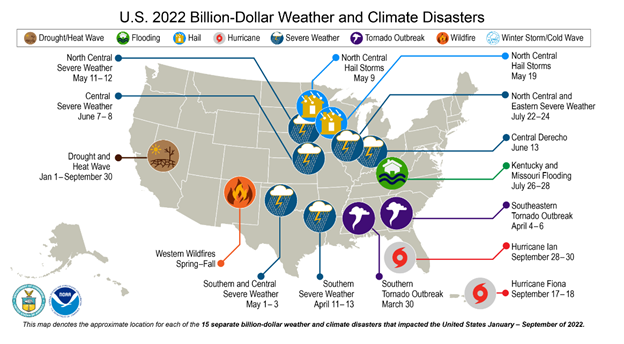Hurricane Ian is the 15th billion-dollar disaster to hit the United States in 2022. The total cost of the 338 >$1B weather/climate disasters we’ve experienced since 1980 is $2.95 trillion. Even more concerning: The 1980–2021 annual average is 7.7 events (CPI-adjusted); the annual average for 2017-2021 is 17.8 events (CPI-adjusted).

This data confirms that $1B climate disasters are not only occurring more frequently, but they are also becoming more powerful and destructive because of increasing climate change.
Economic Recovery Can Take Years
As of this writing, Florida has barely started its recovery from the devastating losses caused by Hurricane Ian. Although final numbers are not yet in, initial estimates predict $75 - $258 billion in property damage and the decimation of one of the state’s prime tourist areas and real estate markets.
But property damage is only one component of the cost of these weather-related disasters. An often-neglected aspect is the cost of business interruption, which causes a decrease in economic activity because of lost revenues or a combo of lost wages and profits. It can take years for a region’s economy to recover, as we saw in Louisiana, Alabama, and Mississippi after Hurricane Katrina in 2005.
Emergency preparedness is often focused on who secures the facility, who comes in, who stays home, and what systems get shut down. Operational resiliency focuses on toughening the facility so that it can withstand disasters and avoid triggering those emergency prep procedures.
Both emergency preparedness and facility resiliency are important for business continuity, avoiding an interruption in your facilities’ operations, and recovering operations quickly post-disaster.
Building Operational Resilience
Operational resilience often focuses on information technology and service disruptions. But, just as your systems need to be available, your facilities are a strategic asset for your organization. They need to be open, secure, and available for the occupants, employees, and guests they serve.
Operational resilience includes processes, procedures, and other initiatives whose focus is limiting risk, exposure, and disruption for a facility’s end users. Operational resilience requires long-term planning and coordination across the entire organization to be effective.
What is operational resilience? Operational resilience refers to processes and initiatives that focus on business continuity management programs. These initiatives typically are focused on limiting risk, exposure, and disruption to occupants, customers, and end users. Operational resilience is more than just a set of activities. It requires careful planning and coordination between multiple teams and stakeholders to ensure everything is accounted for within the plan.
Framework as an Initial Step
As a Facilities Manager/Director, you are likely doing quite a bit of this work already within the context of your daily maintenance tasks. The challenge is that you likely have very little time for any other activities beyond your reactive and preventive maintenance.
Your organization likely has emergency preparedness and business continuity plans in place, but your facility’s resilience also includes factors to be addressed like delayed maintenance and outdated technology that can constrain the ability to respond to a disaster.
From Mitch Comstock (AkitaBox) comes a great suggestion for creating a framework for operational resilience. Although it's basic, this framework can clarify and help prioritize the steps needed for future resiliency planning so that when disaster strikes, your facilities have been hardened and can either withstand damage without business interruption or minimize any disruptions for facility end users.
Document Critical Business Processes
You have a deep understanding of which facilities under your care must be hardened to avoid disruption. This understanding needs to be informed by worsening climate conditions around the world and specific to where your facilities are located. Not every building or every location is vital for uninterrupted operations. Map out priority locations and focus most of your planning and resources on those locations and their facilities.
The severity and frequency of climate-based disasters are accelerating. As a result, the data you may have relied upon in the past may no longer be valid. Review recent weather data and refresh your view of your organization’s vulnerabilities. The National Centers for Environmental Information are a great source for monitoring the climate.
Facility Upgrades
After reviewing the critical factors that impact your vulnerable facilities, you may discover the need to consider and fund upgrades to make those locations more resilient. There are several facility condition assessment tools available – perhaps you have one in your CMMS – that can help provide insight into your facility’s asset conditions. Use this analysis for reference while creating capital budget plans for resiliency-based upgrades.
Implement Targeted Preventive Maintenance
Finally, tighten up and implement a preventive maintenance program targeted for your strategic facility assets, at your vulnerable systems and technology.
Redundancy is your friend in operational resiliency. Make sure your backup systems are always in working order. It can be easy to miss backups during a standard day of maintenance activities. But ignore them at your peril! Some organizations take those backups for granted only to discover that they don’t work properly when they are needed most.
Plan for Recovery
As Mr. Comstock opined “Operational resilience isn’t just about avoiding downtime, but how quickly you can recover. Spend time planning how you would reopen your most critical facilities when a disaster strikes.”
DENS’ facilities experts can help you determine your Life Sciences facilities’ current condition - shoot an email to us at info@densfs.com.


Blog Comments